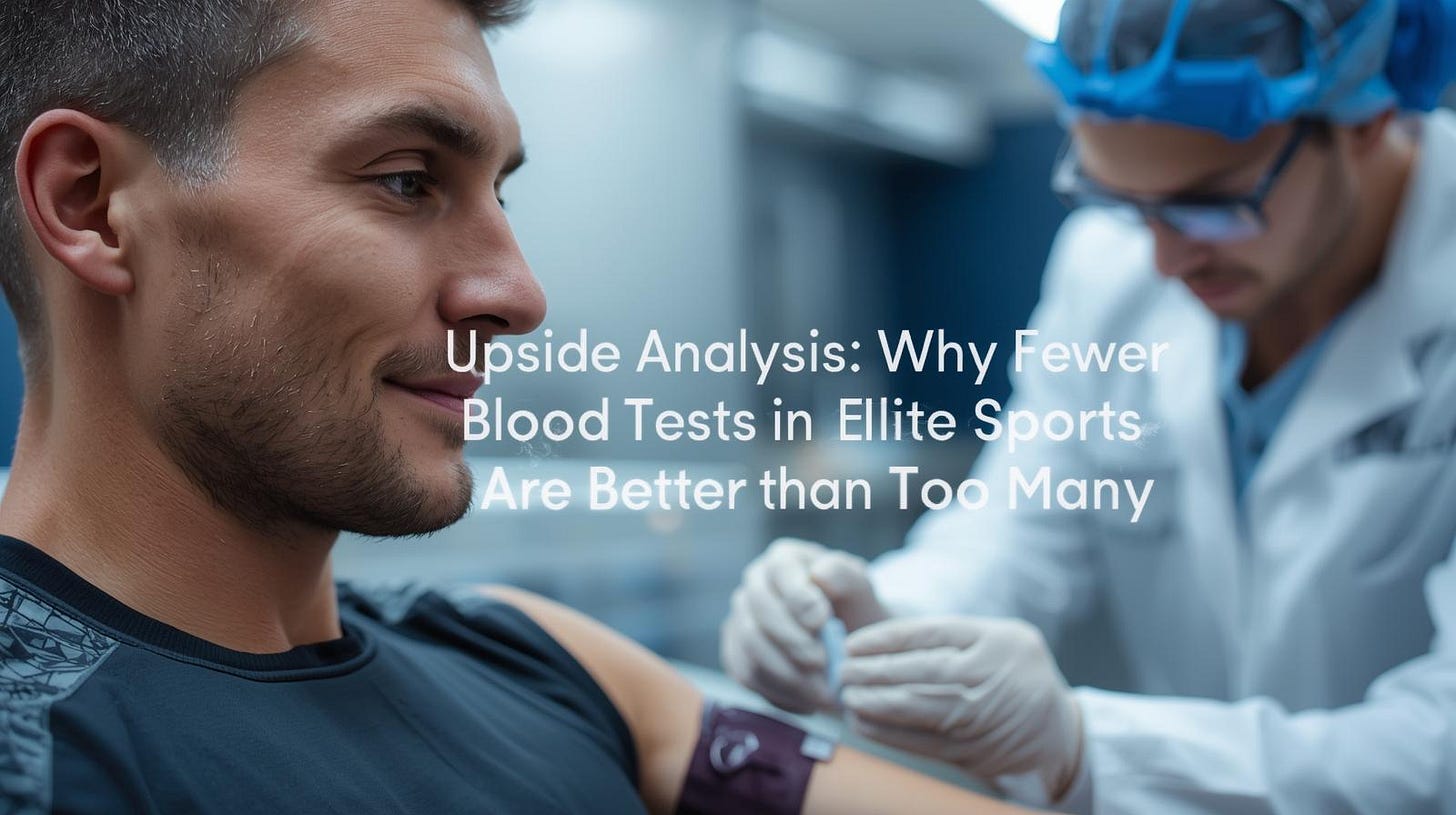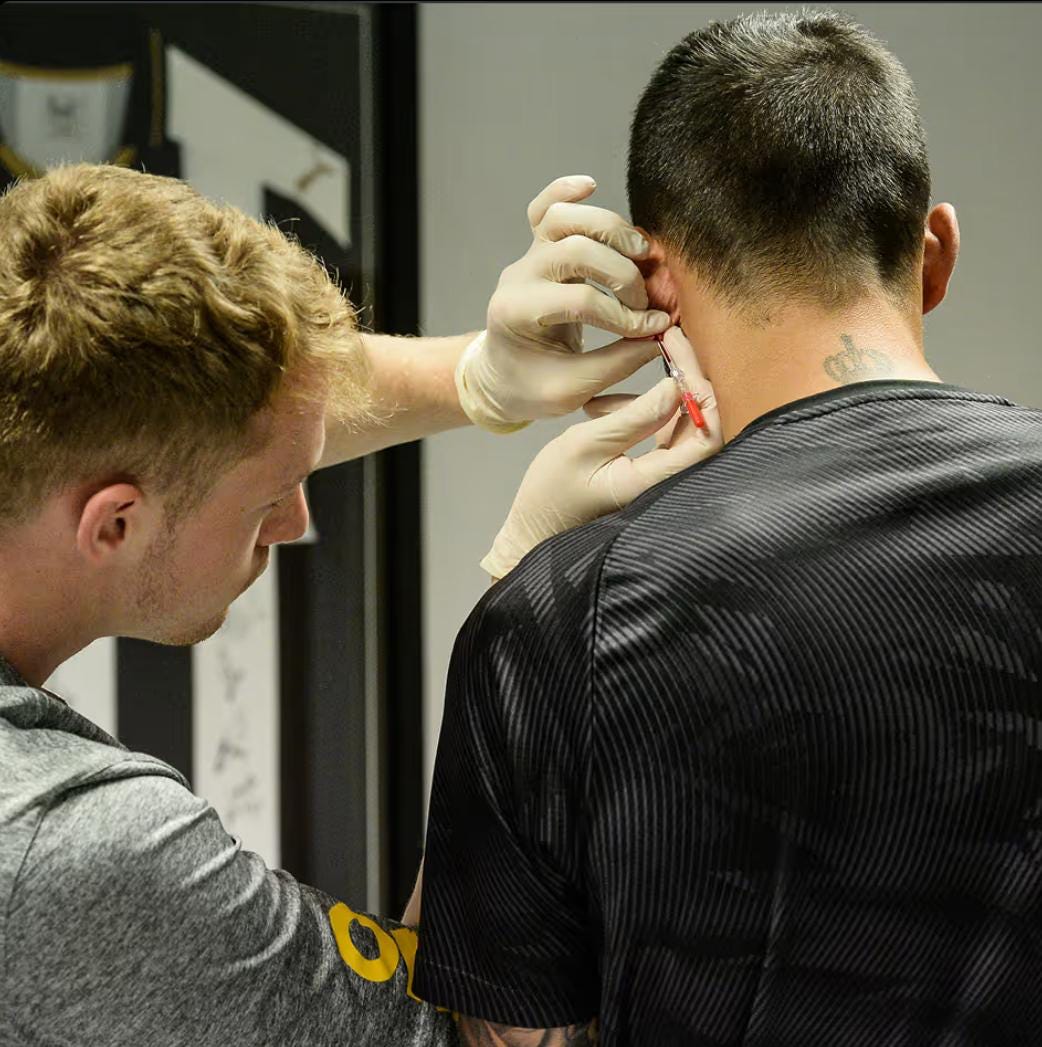🩸Upside Analysis: Why Fewer Blood Tests in Elite Sports Are Better than Too Many
Blood analysis has emerged as one of the most powerful tools in elite sport. It can help teams detect overtraining, undertraining, early signs of illness, and nutritional deficiencies before they translate into missed training days or injuries. However, many teams fall into the trap of over-testing—running too many blood tests without clear decision-making frameworks. This creates unnecessary noise, athlete frustration, and wasted resources. The future of blood analysis lies not in more tests, but in fewer, smarter, and more integrated tests that directly inform performance and recovery decisions.
The Issue: Teams Run Too Many Tests
Elite organizations sometimes run broad blood panels weekly or even more often, without clear thresholds or intended interventions. This creates three core problems:
Noise and false positives: More biomarkers mean more statistical noise. With dozens of analytes, abnormal values are expected by chance, leading to unnecessary concern or interventions (Mayo Clinic Proceedings).
Athlete burden: Frequent blood draws can reduce athlete trust and compliance, especially when they don’t see actionable outcomes.
Resource inefficiency: Broad panels are expensive and time-consuming for medical staff, siphoning budgets away from interventions with clearer impact (e.g., sleep optimization, recovery tech).
Why Fewer Tests—and the Right Tests—Matter
Sharper signal: Fewer but carefully selected biomarkers (such as creatine kinase, cortisol, testosterone:cortisol ratio, and salivary IgA) provide clearer trends tied directly to training load and recovery (PubMed Central).
Athlete-specific insights: Longitudinal monitoring relative to baseline matters more than population norms (Frontiers in Sports).
Actionability over curiosity: Every test should map to a clear action—whether that’s altering training load, adjusting nutrition, or triggering recovery modalities.
Blood Analysis as the “Secret Sauce”
Blood analysis is now considered a hidden competitive advantage. Done well, it allows teams to:
Detect overtraining through markers like reduced testosterone:cortisol ratios (Scientific Reports).
Spot undertraining by identifying blunted immune or hormonal responses.
Predict illness risk through salivary IgA monitoring (Journal of Strength & Conditioning Research).
By integrating these signals with load and sleep data, practitioners can intervene earlier and keep players available.
Key Stats
Illness absences: In elite soccer, median illness absence is 3 days per episode, showing the importance of preventive monitoring rather than blanket testing (PubMed).
Role of illness in male professional football: Not a major contributor to time loss (Bjørneboe J, Kristenson K, Waldén M, Bengtsson H, Ekstrand J, Hägglund M; Br J Sports Med. 2016;50(11):699-702). (Source: PubMed)
Key details:
The study covered 73 European professional football teams over four seasons (2011-2014), with 1,261,367 player-days recorded.
They found 1,914 illness episodes recorded.
They reported a median of 3 days absence per illness episode.
Illness incidence was 1.5 per 1000 player-days.
Key Studies (with URLs)
Blood-based biomarkers for managing workload in athletes (Source here)
Emerging load-sensitive biomarkers (IL-6, HSPs, etc.) (Source here)
Hormonal aspects of overtraining (systematic review) (Source here)
Testosterone–cortisol ratio & stress in athletes (Source here)
Why AI and AMS Integration Is a Winning Formula
Modern Athlete Management Systems (AMS) enhanced with AI are crucial for making blood analysis actionable:
Integration over silos: Biomarker data layered with GPS, wellness, sleep, and training load creates a holistic picture (Source: Orreco + Kinduct partnership). Please note that Kinduct is now part of Teamworks.
Predictive insights: AI can detect patterns (e.g., CK spike + low sleep + poor IgA) that precede soft tissue injuries.
Translation to staff: Dashboards translate complex data into simple green/amber/red flags and recommendations.
Case Studies
Orreco × Orlando City SC (MLS): Orreco’s BioMarkers 3.0 platform provides targeted blood analysis, helping the club individualize training and recovery (Orreco case reference).
Atlanta Hawks (NBA): Orreco helped Hawks players integrate biomarker insights into training load and recovery, reducing overtraining risk (Source: Orreco NBA partnership).
England Women’s National Team (Lionesses): Used Orreco’s FitrCoach and FitrWoman to integrate menstrual cycle, blood markers, and training load to optimize performance (Sky Sports report).
Future of Blood Analysis (5–10 Years)
Less invasive monitoring: Move from venous blood draws to finger-prick, saliva, or sweat sensors for continuous data (NIH Roadmap).
AI-driven digital twins: Personalized models predicting how an athlete will respond to training and nutrition.
Context-aware alerts: Smart algorithms filtering “expected” changes from true red flags.
Federated learning: Clubs sharing anonymized biomarker data to improve global reference ranges while keeping competitive IP safe.
Recommendations to Teams
Define the question before testing. What decision will this test influence?
Adopt lean testing menus. Use broad screens in preseason, then shift to targeted readiness markers in-season.
Build individual baselines. Track changes relative to an athlete’s own norm, not population averages.
Integrate with AMS. Make biomarkers part of the same workflow as GPS and sleep—not standalone reports.
Educate athletes. Explain why fewer, focused tests are more accurate and less intrusive.
Measure ROI. Track reductions in injuries and illness against testing protocols to prove value.
Conclusion
Blood analysis has enormous potential in elite sport, but more testing is not better testing. Oversampling creates noise, false positives, and athlete fatigue. The winning model is to focus on fewer, more meaningful biomarkers, integrate them into AI-powered AMS platforms, and link them directly to actionable decisions. Teams that adopt this approach will maximize player availability, reduce wasted resources, and stay ahead in the performance race.
You may also like:
🩸 Upside Analysis: The Blood Analysis Market in Elite Sports: Full Ecosystem Breakdown (Key Vendors, Use Cases) & Future Outlook
Elite sports is in the midst of a physiological data revolution. While wearables and motion tracking have dominated headlines, blood analysis has quietly become one of the most powerful tools for unlocking performance, managing recovery, preventing injury, and optimizing player health.
🔥 Upside Chat: Dr Brian Moore, CEO, Orreco (Leading Sports & Data Science Platform)
This week, we had the honor to Dr Brian Moore, the CEO of Orreco, a leading Sports & Data Science Platform, which is blending Data Science and Sports Science to generate customized indicators of injury risk, optimal training load and recovery strategies.




